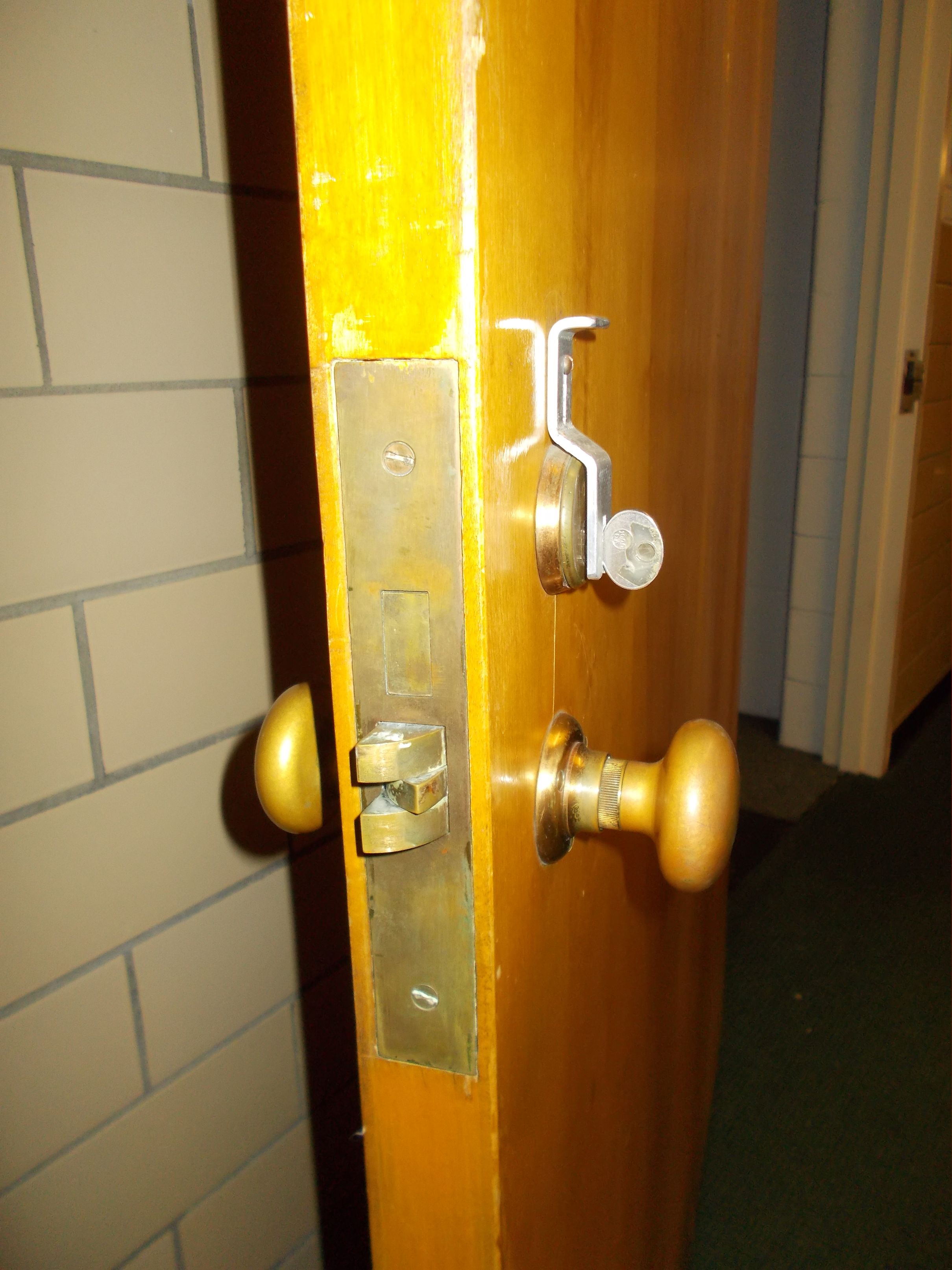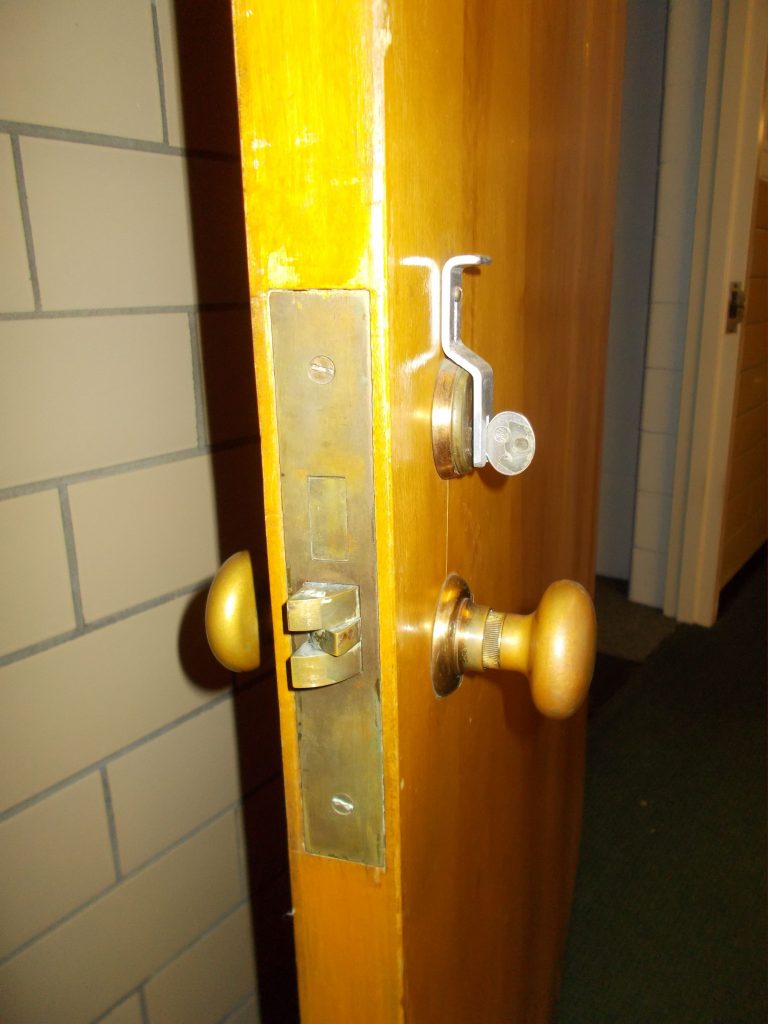Here’s what I know. At one time, this door was in an isolation ward that was part of a Maine psychiatric hospital campus built in 1957. This particular building was built as a tuberculosis facility. The campus was later converted to state offices (for some reason, this gives me the willies). The key is on the egress side of a door that swings out into the exit corridor.
I have my theories about what’s going on in these Fixed-it Friday photos. What say you?
And speaking of Maine…Allegion’s New England office is looking for a specwriter, and I’m not exaggerating when I say that some of my favorite people work there! You can read more about this job opportunity here.
You need to login or register to bookmark/favorite this content.








I don’t think that the modification dates back to the original installation. Most likely, it is a double cylinder deadbolt which does not retract when the inside knob is turned and the mod is there as a reminder that this door must remain unlocked during business hours. If you do happen to get locked in by someone on the outside, you have a key to get out.
Is that metal piece fixed or does it slide up and down in that channel?
I don’t think it slides without loosening the screw.
– Lori
Yes, the door would likely be scratched if the bracket could slide…
Great observation!!
– Lori
Is there a thumbturn on the other side, and the plate is used to secure the door?
Hi Fred –
I think there is a key cylinder on the other side.
– Lori
I assume that it’s to prevent someone from being locked inside the office from the outside. I guess that swapping the inner and outer mortise cylinder never occurred to anyone?
That wouldn’t solve the problem. A thumbturn mortise cylinder woud easily be a much better solution. But to meet code in having only one operation to exit, a new single cylinder lock with the correct function should be installed. But that costs $$, but could also save lives!
Notice there is no keyhole in the door handle. It is probably a set that was intended to retract the deadbolt from the egress side. But it no longer works, so they keep the door unlocked.
I think I’ve been watching too many horror movies. Maybe the key is stuck in the cylinder and sometimes when people are in the room, it locks itself somehow and spooky things happen….
Could the key be on the inside, for the doctors and nurses to control who comes into the TB ward? TB is very contagious.
Just a thought.
So, what’s your theory, Lori?
I think it must have been a double-cylinder deadbolt originally, but when it became office space it was put in the permanently-unlocked position – at least from the egress side. If the key was left in the lock long-term, it seems like the key was not removable in that position, although that’s kind of weird for a deadbolt.
– Lori
It could be that the cam screws have loosened, and the plate is there to keep the plug lined up to allow you to remove the key. We have seen external plates made to keep the plug in place from the outside.
I think the key was inserted on the egress side along with the metal piece to reduce the possibility of anyone on the other side of the door being able to lock it when the door was in the closed position. The deadbolt would not be able to be engaged because of the key along with the metal piece on the egress side would prevent this action, unable to turn.
It appears by turning the key in the mortise housing 180*, with the bolt retracted, you could neither remove the key nor lock the door from the inside. The key on the inside would guaranty the door would not be locked from the outside for any reason. Turning this into a passage function. Of course if you had a finger nail file, a dime or heaven forbid a screwdriver with you, all bets are off!
The lock was keyed both sides for back in the day when they would lock you in the room with the patient staff could have a key to get out. This lock was not ever a single motion egress.
As Russ Hickman states, this is/was an institutional MORTISE lockset at one time. So currently the key retracts the deadbolt to allow passage function. Interesting way to maintain the passage function.
To bring things up to today’s code – probably a new door with appropriate exit hardware would be required.
All good theories but I don’t think they fit. Whatever the reason was, the deadbolt was to remain operable. If the goal was to change it into a passage function, replace the cylinder with a dummy, remove or file off the tailpiece or break the key in the lock. All easier solutions than fabricating the metal slide, that thing took some time and skill to fit so well on the door and cylinder. Also the slide was meant to move up and down. Why would anyone take the time to make the groove or the lip at the top unless it was meant to slide up and down? I agree the lack of scratches on the door would mean it is not used often but still an option.
Maybe someone glued the key in in the past to use it as a thumb turn (key-ring hole was filled), but now they need it as a passage set so they put the bracket on to keep the key from turning.